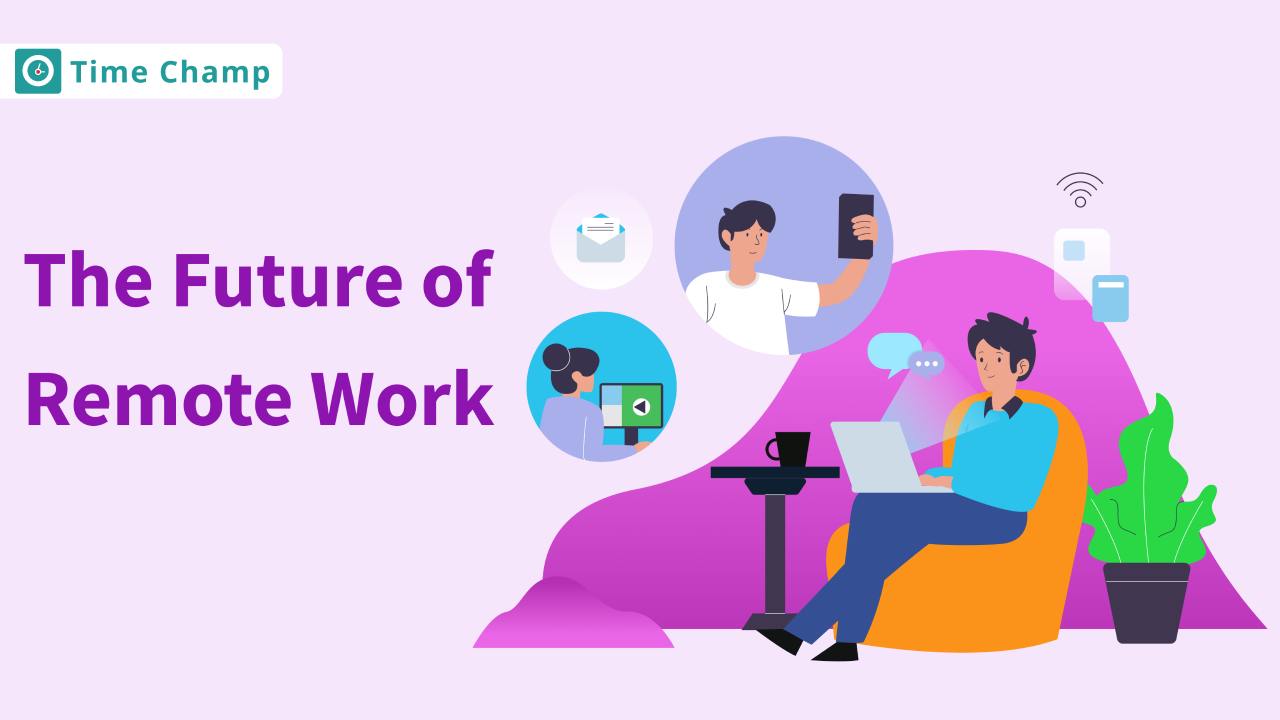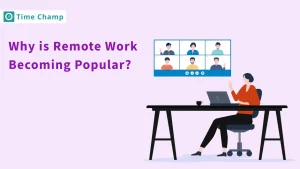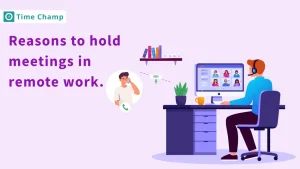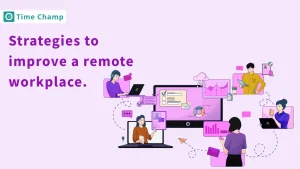In the last decade, remote working has evolved from a rare perk to a normal part of today’s workplace. What was once a luxury, or an exception is gradually becoming the standard for many companies around the globe. A report by Buffer revealed that 98% of remote workers would like to work remotely for the rest of their careers, at least in part. This profound shift underscores how the future of remote work is transitioning from being a concept that was practiced by a few organizations to a standard business model.
The COVID-19 pandemic played a role in this transformation as organizations were forced to quickly shift to remote work scenarios. When the lockdown and social distancing measures were implemented, organizations had to adapt to the changes to continue operations. A survey conducted by McKinsey showed that 90% of managers are convinced that remote work will continue to be a permanent phenomenon in the world of work even after the pandemic. This acceleration in adoption has not only proved that remote work can be done but also the positive impact it can bring.
Across the world, organizations are adopting new flexible working arrangements, observing the positive impact on employees’ morale and performance. According to a PwC study, 83% of employers have found the shift to remote work successful, and many are likely to continue it. With the increasing adoption of remote work as a regular practice in organizations, this blog will discuss the trends, technologies, and the future of remote work.
Current Trends Revolutionizing Remote Work Landscape
Bill Gates once said, “We overestimate the change in the next two years and underestimate the next ten.” This perfectly captures the rapid rise of remote work. In this section, we’ll explore the key trends transforming how businesses and employees collaborate in the modern work environment.
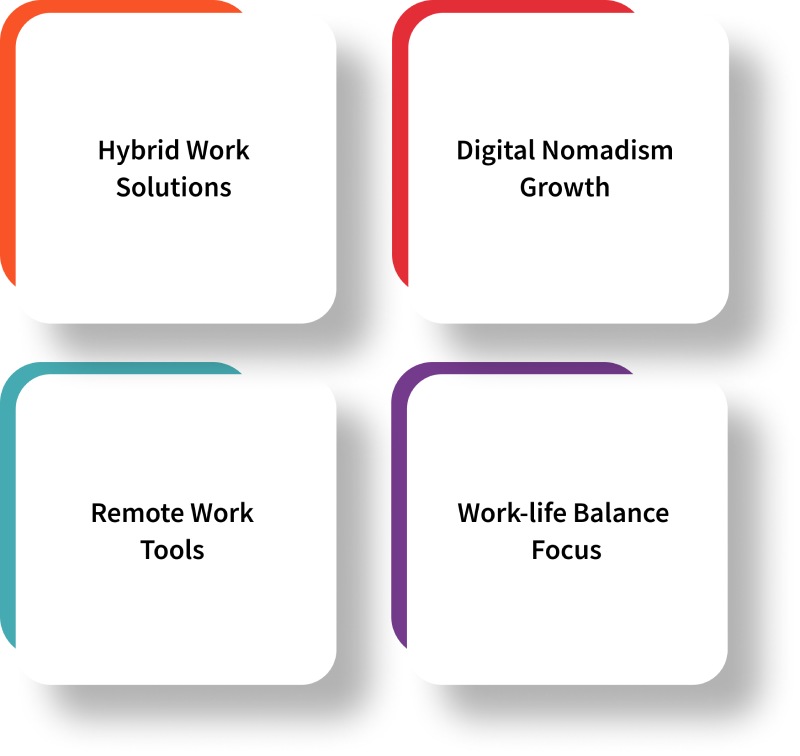
1. Advancing Hybrid Work Solutions
Hybrid work arrangements are becoming more popular as companies try to capture the advantages of remote work while maintaining face-to-face interactions. Quixy revealed that 62% of employees would like to work in a hybrid model where they can work from home and the office. This model is flexible, allowing employees to select their working environment depending on their activities and preferences, thus improving the quality of work-life balance.
Do You Know
A whopping 83% of the global workforce considers hybrid work ideal.
2. Growth of Digital Nomadism
This trend is expected to shape the future of remote work culture, particularly as digital nomads continue to embrace remote work. This lifestyle is especially suitable for young people because it is flexible. A survey by MBO Partners revealed that the number of digital nomads in the United States rose by 49%, reaching 1.1 million.
Today, countries like Portugal and Thailand have come up with visa programs and co-working spaces for this trend. As more people work from home, digital nomadism is set to rise because people can explore new cultures while working.
Do You Know
The remote workplace services market is expected to grow from $20.1 billion in 2022 to $58.5 billion by 2027 at a CAGR of 23.8%.
3. Remote Work Tools and Technology
The increase in remote working has been greatly supported by tools and technology that improve communication and work output. Cloud collaboration, virtual work environments, and real-time project management tools are some of the most promising remote work technologies that are currently driving remote work, as these technologies improve collaboration and productivity in teams. Key tools in this transformation include:
-
Communication and collaboration apps like Slack, Microsoft Teams, and Zoom are now mandatory, and Microsoft Teams alone has risen from 75 million users in 2020 to 300 million in 2023 due to AI and integrated workflows.
-
Tools such as Trello, Asana, and Monday. Com enhances cooperation, with 65% of businesses using cloud-based project management tools in 2022 to work with remote teams.
-
Miro and Figma allow for synchronous creative work, and 75% of workers said that such tools are crucial for remote work, as stated in Forbes.
Do You Know
By 2028, 73% of all departments will include remote workers.
4. Prioritizing Work-life Harmony
Another shift in the remote work culture is the work-life balance, which is the integration of work and personal life to enhance the quality of both. Telecommuting can cause difficulties in distinguishing between home and work life: 22% of employees have problems with disconnection and 18% of employees experience loneliness at work. However, 80% of the respondents said that flexible conditions allowed them to have a better work-life balance, which is essential for long-term career and personal fulfillment.
Do You Know
A FlexJobs survey found that 48% of employees with flexible work options report excellent work-life balance, compared to just 36% of those without—boosting the chances of a healthy balance by nearly 30%
Technological Advancements Shaping Remote Work
A recent report found that by 2025, 50% of all enterprise employees will be working remotely. This shift is driven by advancements in technology that enhance connectivity and productivity. In this section, we’ll explore the key remote work technology trends driving the revolution and shaping the future of remote work.
1. AI and Automation in Boosting Productivity
-
AI Integration: Some of the areas that have benefited from AI include scheduling and customer support. A report from McKinsey & Company shows that AI can enhance productivity by as much as 40% through the use of automation.
-
Automation Platforms: Zapier and IFTTT are some of the applications that help in automating tasks and linking different applications. Forrester’s study shows that companies that implement automation have their productivity boosted by 20%.
-
Machine Learning: The use of machine learning algorithms is improving the operations and offering recommendations which makes it efficient. According to Gartner, by 2025, 50% of team collaboration tools will have AI integration for automation.
2. Cybersecurity and Digital Safety
-
Encryption and MFA: Encryption and MFA are two of the most important aspects of security for remote work. According to Cybersecurity Ventures, companies that adopt these measures have seen their data breaches decrease by 50%.
-
Zero Trust Models: Zero Trust security models improve the safety of remote work since it does not trust any entity by default. Microsoft discovered these models reduce security incidents by 50%.
-
Data Protection: Data protection is critical as IBM reveals that data breaches cost an average of $4.88 million each, which indicates the importance of effective measures in cases of telework.
3. Virtual and Augmented Reality in Remote Work
-
Virtual Reality (VR): VR develops a virtual working environment, which increases productivity and interaction. According to Harvard Business Review, VR training can improve knowledge retention by up to 70%.
-
Augmented Reality (AR): AR makes remote meetings better by adding digital information on top of the physical environment. ABI Research’s study reveals that AR can enhance remote working and decision-making by as much as 40%.
-
Adoption Trends: Remote work is also incorporating VR and AR with 44.2% of companies using these technologies to improve remote communication and collaboration as reported by IDC.
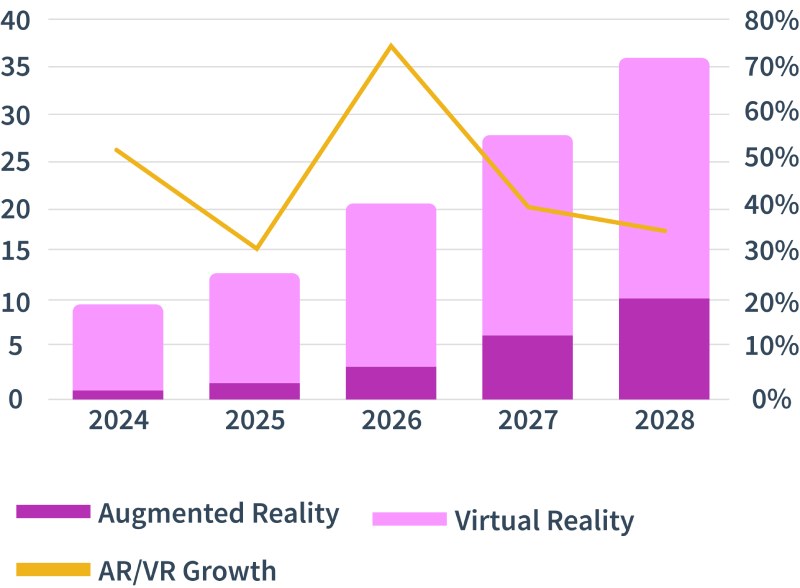
Predictions Shaping the Future of Remote Work
According to Generations at Work Report, support for remote and hybrid work is strong across all age groups, with Gen X leading the way (75%), followed by millennials (56%) and Gen Z (40%). Interestingly, while nearly two-thirds of Gen X (62%) and almost half of millennials (45%) prefer remote work 100% of the time, only 22% of Gen Z feel the same, though 73% favor a hybrid model. These preferences reflect generational differences in how the future of remote work is shaping up, and in this section, we’ll explore what lies ahead for remote work.

The Freelance Boom and Gig Economy Surge
Freelance work and the gig economy have become increasingly popular in the recent past, and the trend is set to continue as more people work remotely. This has been made possible by platforms such as Upwork, Fiverr, and Freelancer which provide businesses with the flexibility of hiring skilled professionals while freelancers have the freedom to work.
-
Upwork’s 2023 Future Workforce Report found that 38% of the U.S. workforce (around 64 million people) are freelancing, contributing over $1.27 trillion to the economy. This represents a 22% increase since 2019.
-
The gig economy is projected to grow by 17% annually, with 52% of companies reporting plans to expand their use of freelancers, particularly for specialized or short-term projects.
Benefits of the Freelance Surge:
-
Flexibility: Freelancers have greater control over their schedules, projects, and clients. Around 80% freelance to be their boss, with 84% of full-time freelancers happier than traditional employees.
-
Cost Efficiency: Freelancing helps businesses save on costs like benefits and office space. The market, valued at USD 1.95 trillion in 2022, is projected to reach USD 5.63 trillion by 2031.
-
Demand for Skills: As industries go digital, there’s rising demand for freelancers with specialized skills. By 2025, 73% of teams are expected to have remote workers.
Growing Role of Employee Monitoring in Remote Work
With the increasing number of organizations that have adopted work-from-home policies, they are using employee monitoring technologies to address productivity and deal with employees who are in different locations. Today, there are many digital monitoring tools and solutions, including AI-based monitoring tools and real-time activity-tracking tools.
-
Gartner research shows that the percentage of large employers that use tools to monitor their workers has increased from 30% before the pandemic to 60% now, and it is projected to reach 70% in the next three years.
-
According to a survey conducted by ExpressVPN in 2021, 77% of bosses install productivity and time-tracking software to monitor their remote or hybrid workers.
Benefits:
-
Enhances Productivity: The use of monitoring tools can improve productivity. Connect Solutions conducted a survey that revealed that 77% of employees working remotely are more productive, with 30% doing more work in the same amount of time as before, and 24% doing more work in the same amount of time.
-
Accountability: The monitoring tools increase accountability among remote employees. Report by Prodoscore Research, knowledge of being monitored increases the concentration and focus on work activities among employees by 47%. This ultimately results in improving overall performances and goal alignments.
-
Transparency: Monitoring practices enhance the level of transparency. A poll conducted by Dtex Systems and Harris Poll shows that 77% of Americans would feel less concerned about monitoring if it were done with proper disclosure.
Do You Know
60% of U.S.-based companies with remote employees use monitoring software.
Tapping into the Global Talent Pool
Perhaps the most significant change that has come with the remote work experiment is the possibility of hiring talent from anywhere in the world. Employers do not have to restrict themselves to certain areas, which means they can hire the best employees from across the globe. This shift not only helps organizations to recruit people for specific positions more effectively but also increases workforce diversity.
-
LinkedIn’s Global Talent Trends Report revealed that 70% of hiring managers will leverage global talent markets more by 2025. Additionally, 62% of companies state that remote work has helped them achieve geographical, racial, and gender diversity in their workforce.
-
Toptal, a company that connects businesses with remote workers and designers, has reported a 400% increase in the demand for freelancers from all over the world, particularly in such fields as software engineering and artificial intelligence.
Benefits:
-
Access to Specialized Skills: Global hiring is advantageous to businesses since it enables them to acquire specialized skills at a lower price. A report by Global Workplace Analytics shows that remote work has increased by 159% since 2005, which has helped companies source talent from around the world.
-
Cost-Effective Hiring: Global hiring can reduce labor costs significantly. For instance, developers from Eastern Europe or Southeast Asia cost 40-60% less than domestic hires. The World Economic Forum notes that global talent can cut labor costs by up to 50%.
-
Cultural Diversity and Innovation: A global workforce is more creative and effective in solving problems. Steve Jobs once said, “Innovation is saying no to a thousand things.” Diverse thinking can create new ideas and open up new markets.
Do You Know
46% of women prefer full-time remote work, compared to 39% of men
Key Takeaways:
-
The transition to remote work has become a standard business model, with 98% of remote workers desiring to continue working remotely in some capacity.
-
Hybrid or remote hybrid work arrangements allow a growing preference to equilibrate work between onsite and remote settings, hence enhancing work-life quality.
-
Advanced tools, such as AI, cloud collaboration platforms, and project management apps, are crucial for enhancing productivity and communication in remote teams.
-
The growing phenomenon of freelancing, supported by digital platforms, offers flexibility and access to global talent pools, having an enormous influence on the workforce landscape.
-
With increased adoption, new monitoring technologies are making remote workers more accountable and transparent, and therefore more productive and focused.
Stay ahead of the remote work revolution with Time Champ
The ultimate tool for tracking employee time, productivity, and performance.
SignUp for FreeBook DemoFrequently Asked Questions
In a remote or hybrid work environment, leadership styles evolve for trust, effective communication, and inclusivity. Managers will have to adjust to using tools that ensure transparency, promote collaboration, and help them support employees from anywhere. It is more about engaging, managing distributed teams efficiently, and creating a culture that balances flexibility with productivity.
Most Companies recognized all the benefits of teleworking, such as greater productivity and access to a wider talent pool. Some organizations are reverting to a more traditional office model, but many others are opting for hybrid or fully remote models. Trends suggest that companies will need to continue to offer options for remote working arrangements to attract and maintain their talent as this is precisely what talent now seeks.
The skills required in a remote working environment will cut across digital communication, self-motivation, and adaptability. All these would be highly promoted as you must be properly equipped to collaborate tools, possess strong emotional intelligence, and have the ability to learn and upskill yourself along with the changing technology and workplace dynamics.
Companies looking to adopt a remote work policy, need to adapt to labor law, tax implications, and data protection regulations. Clear remote work agreements that abide by the local employment law can work to minimize some of these legal risks.
